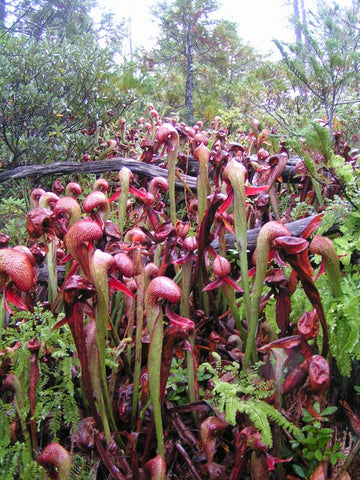Cobra Plants (Darlingtonia californica) Growing Tips
 Sun: Darlingtonia appreciate full sun but do not like heat. To avoid overheating in cultivation, you may have more success growing in the morning sun only or in filtered all-day sun. We grow ours where they do not receive full afternoon sun, as our area is quite hot. This protection from the intensity of the hottest portion of the day is essential to keeping them happy. Shade the pots, if possible, to keep the solar heat at a minimum.
Sun: Darlingtonia appreciate full sun but do not like heat. To avoid overheating in cultivation, you may have more success growing in the morning sun only or in filtered all-day sun. We grow ours where they do not receive full afternoon sun, as our area is quite hot. This protection from the intensity of the hottest portion of the day is essential to keeping them happy. Shade the pots, if possible, to keep the solar heat at a minimum.
Water: Use the tray method, keeping the soil damp to wet year round. Keep the soil cool by watering it with cold water (refrigerated water is quite helpful on warm summer days).
Temperature: Very hardy in winter and can take temperatures down to 15 degrees. They are, however, susceptible to heat, especially in the roots. The ideal root temperature would be 40-55 degrees. Warm roots can kill them quite rapidly. They can tolerate 15-90 degrees with brief heatwaves if sheltered from the most intense summer sun and their roots are kept cold. Grow them in large, insulated Styrofoam coolers, in recirculating water, or poor cool, refrigerated water on their roots in summer. These can be grown indoors, and a grow light is recommended.
Dormancy: All Darlingtonia require a winter dormancy. Many of the pitchers will turn brown and die back during this time. Leave them outdoors in full sun, sitting in distilled water during this period if you live in an area that snows over winter, or indoors on a sunny windowsill in an unheated room or garage. Still sitting in full sun and distilled water. Or mulch them in heavily outside with four inches of mulch on the top and sides of the pot. Darlingtonia would normally be covered in light to heavy snowpack where they grow natively, as such they do not begin to break dormant and actively grow until the snowpack would melt, which is usually May or June.
 Soil and Repotting: There are many good mixes for Cobra plants. You can use three parts New Zealand long-fibered sphagnum moss to one part pumice or lava rock. Or two parts lava rock and or pumice to one part peat. The mix should be airy, and the inert ingredients will help cool the roots. Live sphagnum makes an ideal media as well. Do not repot plants when you receive them from us, as they do not need to be repotted, and it will cause shock. Repot every three years in the winter when the plants are dormant.
Soil and Repotting: There are many good mixes for Cobra plants. You can use three parts New Zealand long-fibered sphagnum moss to one part pumice or lava rock. Or two parts lava rock and or pumice to one part peat. The mix should be airy, and the inert ingredients will help cool the roots. Live sphagnum makes an ideal media as well. Do not repot plants when you receive them from us, as they do not need to be repotted, and it will cause shock. Repot every three years in the winter when the plants are dormant.
Fertilizer/Feeding: MaxSea fertilizer can be applied once per month to the plant's leaves and pitchers. Dilute 1/4 teaspoon of MaxSea fertilizer into one gallon of distilled water and use a mister bottle to mist the leaves. Avoid pouring through the soil.
Growth Habit: Darlingtonia grow tall pitchers from rhizomes in the soil. They produce stolons that wrap around their pots, and new plants will grow from them. Darlingtonia die back to their rhizomes in winter, when they are dormant. They begin to develop their new pitchers for the year in May or June and produce many pitchers until winter when they die back. These pitchers can be cut back to the base of the plant when they turn brown fully.
More Information: For more information on repotting, pests, growing habits, and more, check out our FAQ page or our YouTube channel!



